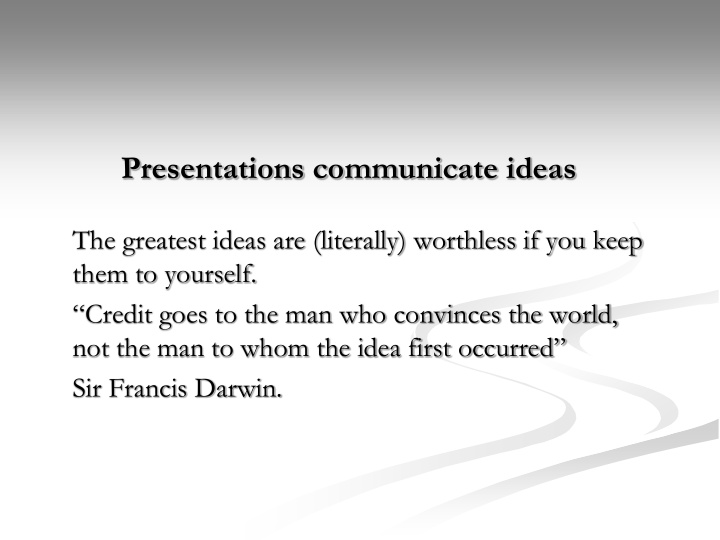



Presentations communicate ideas The greatest ideas are (literally) worthless if you keep them to yourself. “Credit goes to the man who convinces the world, not the man to whom the idea first occurred” Sir Francis Darwin.
Overview Knowing your audience Planning Delivery Body language Aids aid
Presentations Opportunity to tell and show Interactive experience Present yourself as well as the talk Depth and scope determined by audience
Principles of effective presentations Be interesting Persuade your audience that they are true Communicate your arguments and evidence
Three E’s Educate Explain Entertain (Paul N. Edwards, University of Michigan 1998-2004)
Your listeners are listening “Listeners” listen between 25% -50% of time Short term memory holds 5-7 points People remember 10% of what they hear vs. 50% of what they read Window of communication = 2.5 - 5.0% of your total presentation time
Engage the brain ‘’People learn better from words and pictures than from words alone.’’ (Mayer and Anderson, 1991)
Different learning styles Visuals Statistics Analogies Demonstrations Testimonials Artefacts Exhibits
The four P’s to make it work PLAN PREPARE PRACTICE PRESENT
Where to start ? Brainstorm for: Why? PLAN Who? What? PREPARE How? PRACTICE When? Where? PRESENT
Plan – the core message Define the objective of talk based on: Why? Who? Reason for presentation Pitch the audience Impact on audience (size, age, gender, What action knowledge, bias, culture) Talk to your audience rather than at them
Structure - shape the talk Introduction Tell them what you are going to tell them Body Tell them Summary Tell them what you told them
Scaffolding of presentation Introduction Grab attention Something dramatic State objective Why they should listen? Highlight ideas Range of talk Body Persuade 3-5 main themes Inform Introductions and summaries Entertain Summary No new material Restate Points Memorable as opening Point the way forward Incite to action
Practice makes perfect Delivery Watch your body posture Use a conversational tone Eye contact – 90% of speaking time Smile Vary the pace, pause
Body language 55% Visual 38% Verbal 7% Tonal 93% of communication is non verbal Prepare for the ear Three dimensional
AIDS AID Flip Charts and White Boards Overhead Projector Slide Projector PC & Data Projector Video/Multimedia Handouts
Tips for effective slides Keep it simple (6X6 rule) One idea per slide Good visuals are visible 10% of men: red/green colour blind No advance information “Life span” of each visual The art of science communication:using PowerPoint effectively at http://ian.umces.edu/pdfs/science_comm_powerpoint.pdf
Tips for effective slides Use landscape format preferably Use large lettering Use pictures, figures, titles, or short, clear caption Avoid data in tables or in text Avoid complete sentences, use “headlines” Remove all information from figures that is not absolutely necessary
Tips for effective slides Combine left & right brain sensory channels Left brain: words, sentences, Right brain: graphs, charts,symbols, pictures Change sequence of eye scanning - horizontal, vertical, diagonal
Logistics When & Where Attendance Check out room Test equipment Adapt layout Arrive early
Q&A pointers “What questions do you have?” vs. “Any questions?” Most interactive part Eliminate barriers Repeat or restate Respond simply and directly Be patient
Final pointers Checklist One main idea Simple The ‘rule of three’ Less is more Big start Seize attention Bigger finish Be memorable Demand action
How well you present your material directly impacts on how well it is received. “ A speech is a solemn responsibility. The man who makes a bad thirty-minute speech to two hundred people wastes only half an hour of his own time. But he wastes one hundred hours of the audience's time-more than four days-which should be a hanging offence.“ Jenkin Lloyd Jones
Recommend
More recommend